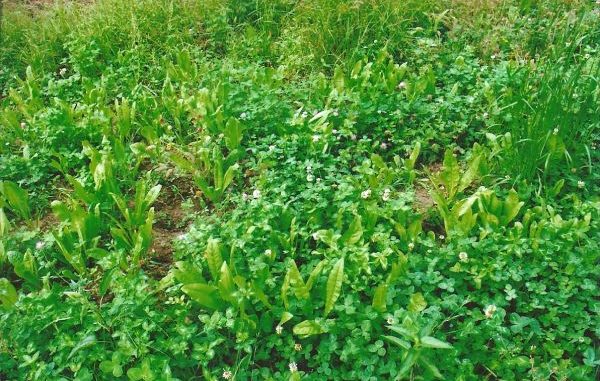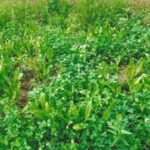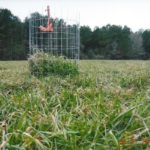
A very cold winter and a poor mast crop has made it tough for whitetails
In the movie Groundhog Day, Bill Murray was stuck in time on a cold winter’s day that would never end. While the cold weather this year made for a great deer season, this winter in Louisiana has been one that seemed like it too would never end.
At the Moreland house we have burned more wood in the fireplace than ever. The regular freezes have taken a toll on the yard vegetation around Baton Rouge, and no doubt the nurseries owners are gearing up for an increase in spring plant sales.
The whitetails have had to be on the move in search of quality forage to meet their nutritional demands while staying warm during this exceptionally cold Louisiana winter. There were some white oak acorns in Clinton during the early part of the season, but they were gone by mid December.
The red oak acorn crop appeared to be a bust, and the deer activity in the green fields was exceptional. If you had a high deer population on your land this year, hopefully you took advantage of the activity around the green fields and reduced your numbers in an effort to keep the herd in balance with the habitat.
Unfortunately most hunters these days just enjoy seeing deer and do not harvest the number of deer required to achieve quality growth and development.
The photograph of the excluder cage in this green field clearly shows the browsing pressure that has been exerted by deer on the green forage this winter. In some cases the food plots have been so over-browsed that they look like someone just painted the dirt green; there is no plant growth.
I have heard some hunters say they did not put enough fertilizer on their patches or that the seed did not germinate. The reality is they simply have too many deer, and rather than spending time and money on the plantings they needed to spend money on bullets and knock the herd back.
But it is too late now, and if you do not have good forage plantings with sufficient quality protein forage for the deer during spring and early summer, you might be in trouble.
I spent some time looking at the native forages in the woods, and it was apparent that deer were working hard to find available browse. In the woods on a tract of land in Morganza the primary browse was rubus (blackberry and dewberry), and it was being hammered. Fortunately, blackberry is a plant that will quickly sprout new growth on the warm days and can tolerate heavy browsing.
The smilax or greenbriar had been heavily browsed, and most of the plants were just thorny green stems without any leaves.
Honeysuckle was present but because of past years of over-browsing I had to get on my knees to find it growing on the ground. Occasionally a vine could be found growing up on a small shrub, but it was apparent the deer were pretty much keeping the growth down.
The only other browse plant that was available was the small oak seedlings that had sprouted from last year’s mast crop and had not been zapped by the freeze. Thank goodness the landowner had worked hard and planted the fields and roadsides with mixtures of winter grass, clover and other forages such as chickory. There was absolutely no mast crop available and, because of bears and hogs, the landowner does not use corn feeders during the season.
If you haven’t taken the time to look at your winter habitat, now would be a good time to see exactly what is available for the deer and perhaps begin planning a few timber cuts.
The problem with native winter browse is that most of it goes into a dormant growing stage in the fall; the leaves fall off and the only food available for deer are the stems that have little nutritional value.
In Clinton the old privet shrub that is much detested by foresters provides winter browse for our deer, and it has really been hammered this year.
It doesn’t take a Ph.D. to recognize deer browsing, so take some time and look over your habitat. You can also contact the biologists at LDWF, and ask them to come out and look over your habitat.
The rut takes a toll on the bucks during the winter; all that chasing and carrying on with the does causes the bucks to lose weight, and by the end of the breeding season a mature buck is pretty much run down.
During the rut the buck decreased his feeding but at the same time increased his activity. Add to this a cold winter and the energy demands to stay warm, and it is no wonder that bucks lose body weight — anywhere from 20 to 40 pounds.
Once the rut is over, the need to feed again becomes a priority. If the habitat has sufficient browse or there are acorns available for the deer, deer can start catching up with the weight that has been lost. If quality forage in the food plots and fields are available, the deer do not have to work as hard.
However, if there is no hard mast, if the woods have insufficient browse or if all that is available to the deer in the food plots is some rye grass, then it is going to be a difficult task for the animals to catch up and get ready for new body growth and antler development. The bucks and pregnant does will spend all their time and energy catching up and very little is available for the new growth. Bucks will display low body weights and poor antler development next fall, and the reproductive potential for the does might also be impacted.
Therefore, since the mast crop was so poor this past year and with the hard winter that impacted the native forages, it is a must that clubs and landowners have good, quality forages available for deer this spring and summer.
Clover in the food patches and fields was certainly one way to have provided a good source of protein for the deer during spring and summer. Chickory is another plant that provides good forage for deer in the spring. But this required a little planning last fall, and if all you did was throw out some wheat or rye grass seed, your herd is not going to have the forage needed for quality growth and development. If you are relying on your native forages then hopefully you have done some logging — either some clear-cuts or thinnings — that will put sunlight on the ground and grow quality browse.
If your plantings lack the quality forages that will meet the nutritional demands of a growing deer, you might want to consider planting as early as you can this spring. Forages such as peas or beans will provide the necessary protein for the deer. The grain crops will provide food in the fall, but the immediate demand of the deer is for the early growing season, when the bucks are growing a new set of antlers and the does are beginning to fawn.
The challenge is to be able to plant enough in time to meet the demand of the deer without the forage being eaten up as soon as it germinates; otherwise it will do no good.
As I often preach, deer management is a year-round activity that requires long-range planning in order to achieve quality results. There were numerous quality bucks killed this past season because of the carry-over from a poor 2012 deer season when there was no winter. The 2013 winter has been a time of stress for the deer, and without some help from us hunters, the availability of quality bucks during the 2014 season might be less than desired.




